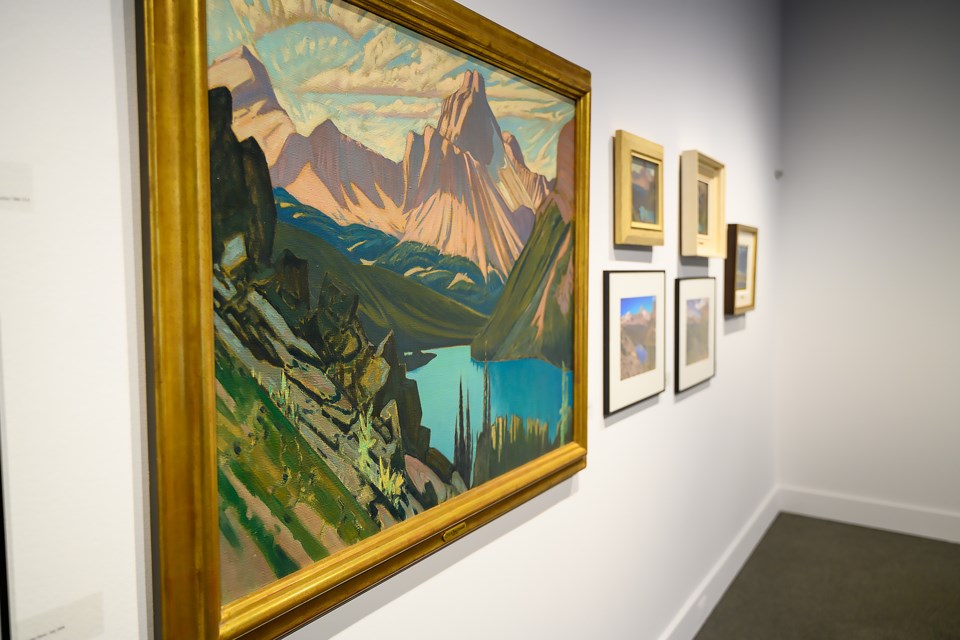BANFF – Paints, canvases, easels and brushes get loaded on top of a horse alongside camping gear as James Edward Harvey (J.E.H) MacDonald readies himself for an art getaway into the Lake O’Hara region.
With camp set, the Group of Seven artist finds a view of the iconic lakes and peaks to mimic with his paints. Going from lake to lake, finding ideal viewpoints, he leaves only the trace of some leftover paint and some tea making supplies.
The first trip in 1924 became an annual outing untill 1932 where he was joined alongside Catharine and Peter Whyte, among other esteemed painters.
Now a century later since his first trip to the lakes, and hundreds of paintings, MacDonald's story is retold in the Whyte Museum of the Canadian Rockies' newest exhibition that's open until Oct. 20.
“It's interesting to see people come through because they get quite emotional when they see these things,” said Donna Livingstone, CEO of the Whyte Museum. “I think it tells a wider story than just a plain art show.”
The retelling was made possible when geologists and married couple, Stanley Munn and Patricia Cucman, were launched into a 20-year rabbit hole of research on MacDonald's time in the Lake O’Hara region.
“Their stamina to follow through is abundantly clear in this exhibit and had they not done this, the show wouldn't be on the wall,” said Anne Ewen, the Whyte Museum’s chief curator of art and heritage. “They are the stars of this show. This is 20 years of their life.”
By examining MacDonald's paintings, diaries, letters and photographs, Munn and Cucman retraced his steps to find the exact location where he placed his easel. Even finding leftover paint scraped onto rocks, mugs and billycans, some of which are on display.
“I saw two rocks piled up on top of each other that looked not natural. And then I sat on them, there was paint on them and the painting composition just snapped into view,” said Cucman.
The scrapings were sent to the Canadian Conservation Institute in Ottawa where they were confirmed to be from the years MacDonald painted at the lakes. Although, because the Group of Seven artist was joined by other painters, it’s not been confirmed as to who left the oil based paint on the rocks.
However, Cucman is convinced that it is MacDonald's.
“You sit on a rock and the painting is in front of you and the paint is beside you, you're going to have a hard time convincing me that it's not his paint,” said Cucman.
Working as an organized team, Munn focused on the landscapes in relation to the paintings as well as recreating the art with photographs. Looking into the diaries, letters and trip reports was where Cucman took aim and found connections in their research.
“When he did his image and painting descriptions, I could bring in diary and letter excerpts that were relevant to those things,” said Cucman. “Finding the connection between little bits of data was really my thing.”
Munn’s photographs not only give insight into what MacDonald saw, but it also shows the change and growth of the landscape decades later.
The long hours of research, transcriptions of letters, calendars and details that aren’t shown in the exhibit have been published in Munn and Cucman’s book, To See What He Saw. It's available in the Whyte Museum's book store.
“It's all their research. There are records in there that haven't been published before, letters that haven't been published,” said Ewen. “Patty and Stan got to know J.E.H’s great niece very well and she generously lent them materials that they've published as well.”
Through Munn and Cucman’s own interest in Lake O’Hara they found out about MacDonald by attending a book talk with Lisa Christensen who wrote a book on MacDonald and his work in the region. It was then that they were told that the locations of where he painted were impossible to find.
“Somebody said, ‘oh, you can't find the exact locations of any of these paintings because they were very interpretive,’” said Cucman.
At the book talk in 2003 they saw a photograph of MacDonald, the Whytes and Adeline Link, and were determined to find out where it was taken, instead of finding the painting locations.
“It was two O'Hara visits later in 2006 when we actually found the photo location, and when we found the photo location, we realized you can find exact painting locations,” said Cucman, who’s visited the Lake O’Hara lodge 34 times.
Out of the 216 paintings MacDonald created in the Lake O’Hara region, Cucman and Munn found 214 of the locations.
“We sat on the same rock that McDonald sat on," said Cucman. "Some of them we know were real close, but the vegetation has grown to the extent that you can't actually sit there anymore."
To complement the work of MacDonald in the Rummel Room at the museum are the works of Peter and Catharine Whyte, among other talented painters which also feature views of the Lake O’Hara region.
CORRECTION: The story originally stated MacDonald camped at Lake O'Hara and painted with acrylics. He stayed at Lake O'Hara Lodge and his work was largely done in oil paint, with some exceptions being ink or graphite on paper. The story has been updated and the Outlook apologizes for the error.




